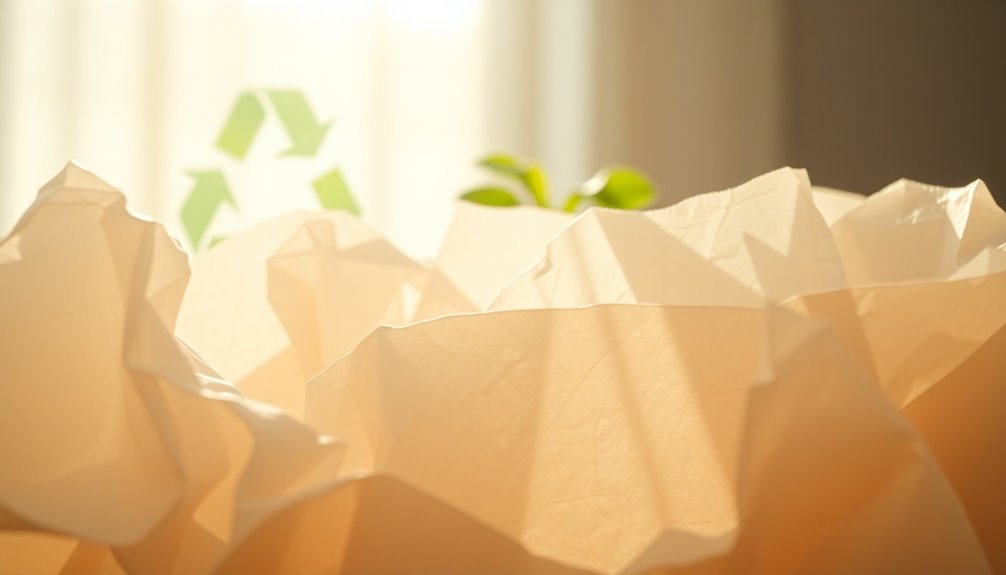Tissue paper is soft, lightweight, and smooth with a delicate feel, making it perfect for gift wrapping, flower accents, and elegant decorations. Crepe paper is more textured, stretchy, and vibrant, ideal for bold, dynamic projects like streamers or handcrafted decorations. While tissue tears easily and is less flexible, crepe holds shapes well and resists tearing. To choose the best material for your project, explore the detailed differences and best uses further.
Key Takeaways
- Tissue paper is thin, delicate, and smooth, ideal for gift wrapping and delicate crafts; crepe paper is textured, stretchy, and vibrant for bold decorations.
- Crepe paper offers high flexibility and elasticity, making it suitable for shaping and textured designs, while tissue is more fragile and suited for soft accents.
- Tissue paper generally costs less due to simpler manufacturing, whereas crepe paper involves complex processes, making it more expensive.
- Both materials vary in environmental impact; recycled fibers and eco-friendly options are emerging, but production still consumes resources and water.
- Use tissue for elegant, subtle touches; use crepe for lively, textured decorations like banners, streamers, and floral arrangements.
Material Composition and Texture

Tissue paper is typically made from thin, soft pulp derived from wood or recycled fibers, giving it a light and delicate feel. The fiber blend influences its overall texture and strength, with a higher proportion of virgin fibers creating a smoother, more uniform surface feel. Recycled fibers may introduce slight variations, resulting in a softer, less polished surface. This composition allows tissue paper to be gentle against your skin while maintaining flexibility. The surface feel is smooth yet lightweight, making it perfect for wrapping delicate items or facial tissues. Its fine fiber blend ensures it’s soft without sacrificing durability. Overall, the material composition directly impacts how the tissue paper feels in your hands and on your skin, emphasizing its purpose for gentle use. Additionally, the material composition can affect how environmentally friendly the tissue paper is, depending on the sources of fibers used. Advances in sustainable materials are leading to more eco-friendly tissue paper options, which are becoming increasingly popular among consumers.
Appearance and Color Options
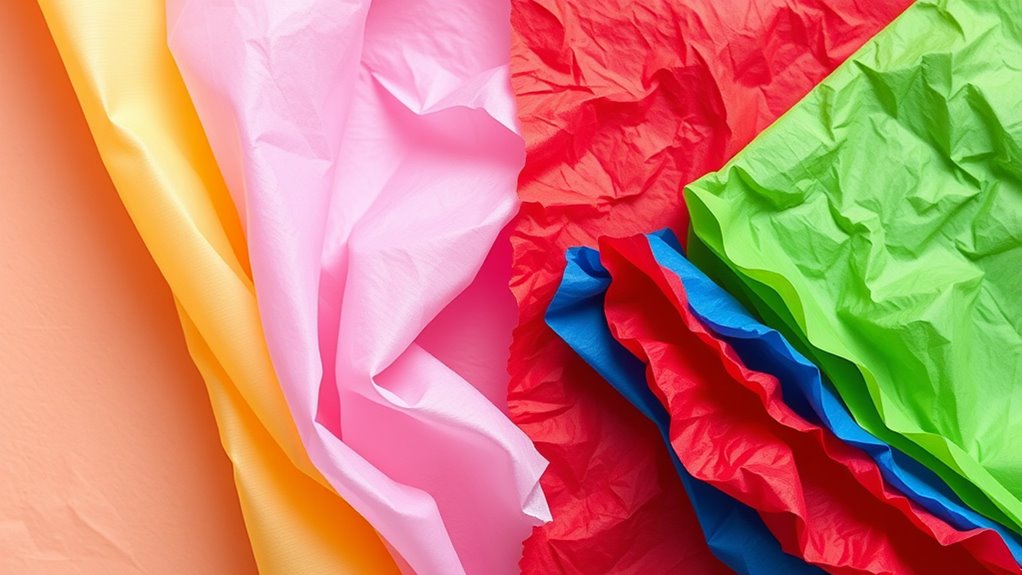
Both tissue and crepe paper come in a vibrant range of colors that can match any theme. Their textures and finishes add unique visual effects, making your decorations stand out. Plus, a variety of patterns and designs let you customize your look perfectly. Additionally, best paper types are chosen based on their suitability for different occasions and purposes, ensuring the right material for each event. The appearance and color options of these papers can also influence the overall ambiance of your project, allowing for greater creative expression. Considering the cost of these materials can help in planning your project budget effectively. Understanding paper texture and finish is essential for selecting the ideal paper to achieve your desired aesthetic.
Bright Color Palette
When choosing between tissue paper and crepe paper, their bright color palettes stand out as a key factor. Tissue paper offers a wide range of vibrant hues that blend seamlessly for smooth color gradations, perfect for delicate decorations. Crepe paper also features bold, vivid colors that pop, making it ideal for eye-catching displays. Both materials excel in pattern matching, allowing you to coordinate shades precisely with your theme. Tissue paper’s softer tones are great for subtle accents, while crepe paper’s intense colors add energy to your projects. The variety of available shades ensures you can find the perfect color palette for any occasion. Whether you prefer the gentle blending of tissue paper or the striking vibrancy of crepe paper, their bright color options enhance your creative possibilities. Additionally, understanding personality traits can help you select the most suitable materials for your personal style or project theme. Recognizing the durability and handling characteristics of each material can also influence your choice for long-lasting decorations or crafts. Moreover, some colors may fade over time if not properly cared for, so considering the colorfastness of each paper can be important for lasting projects. Being aware of the variety of shades available enables you to create cohesive and visually appealing designs that suit any occasion.
Texture and Finish
While tissue paper tends to have a smooth, matte finish that gives your projects a soft, delicate look, crepe paper offers a textured surface with a slightly crinkled appearance that adds dimension and movement. This difference in texture influences how you use them in decorative crafts and gift wrapping. Tissue paper’s subtle sheen and flat surface create a clean, elegant backdrop. Crepe paper’s ruffled texture brings vibrancy and a lively feel to any project. Additionally, the texture and finish of these materials can significantly impact the overall aesthetic and tactile experience of your craft. Understanding the material properties can help you choose the right paper for your specific project needs.
Pattern and Designs
Tissue paper and crepe paper each bring their own distinctive patterns and color options that can dramatically influence your craft projects. Tissue paper offers a wide pattern variety, including solid colors, metallics, and subtle prints, giving you design flexibility for delicate decorations. Crepe paper, on the other hand, typically features more vibrant, consistent colors with a textured appearance, ideal for bold, lively designs. Here’s a quick comparison:
| Pattern & Design | Appearance & Color Options |
|---|---|
| Tissue Paper | Soft, subtle, varied prints, pastel hues |
| Crepe Paper | Bright, textured, single-color options |
| Pattern Variety | Extensive, delicate patterns |
| Design Flexibility | High, adaptable for fine details |
| Color Options | Wide range, including metallics |
Flexibility and Tear Resistance
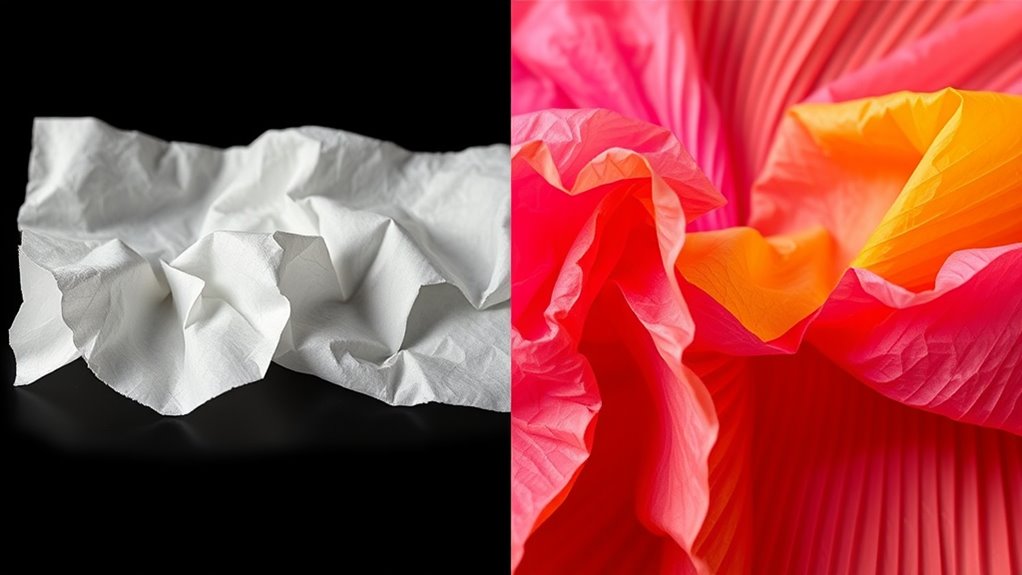
You’ll notice that crepe paper is more flexible and stretchy than tissue paper, making it easier to mold into various shapes. Tissue paper, however, tends to tear more easily under pressure, limiting its durability. Understanding these differences can help you choose the right material for your project’s strength and flexibility needs. Additionally, material properties can influence how well each paper type performs in different craft applications, especially when considering factors like tear resistance and stretchability. Recognizing fiber composition differences can further assist in selecting the appropriate paper for specific uses. The manufacturing process also plays a role in determining the final texture and strength of each paper type.
Flexibility Comparison
Both tissue paper and crepe paper exhibit distinct differences in flexibility and tear resistance, which directly impact their usability. You’ll notice that crepe paper is highly flexible, allowing you to easily mold and shape it for wrapping techniques or decorative accents, making gift wrapping more dynamic. Tissue paper, while delicate, is less stretchy and prone to tearing if overstretched, limiting its flexibility. Additionally, crepe paper’s aesthetic appeal makes it a popular choice for textured decorations and elaborate crafts. Crepe paper easily stretches around curves and shapes, providing versatility in design. Tissue paper tears with minimal tension, which can be beneficial or limiting depending on the application. Crepe paper holds ruffles and folds well, enhancing decorative effects. Tissue paper remains fragile under pressure, requiring careful handling. Crepe paper adapts to intricate wrapping designs, which is ideal for creative projects and allows for versatile application. Recognizing these differences helps you select the appropriate material based on the desired flexibility and durability for your project, whether it’s sturdy wrapping or delicate decoration. Flexibility plays a vital role in achieving professional-looking gift wrapping with ease.
Tear Resistance Strength
Crepe paper’s high flexibility does not come at the expense of tear resistance; in fact, it generally offers stronger resistance to tearing under tension compared to tissue paper. During durability testing, crepe paper’s elastic nature allows it to withstand material stretching without ripping easily. Its ability to absorb tension means you can stretch and manipulate it without compromising its integrity. Tissue paper, on the other hand, tends to tear more quickly when stretched or pulled, indicating lower tear resistance. This durability difference is vital depending on your needs—crepe paper is better for projects requiring strength and flexibility, while tissue paper suits delicate, decorative purposes. Overall, crepe paper’s material stretching capacity makes it more resistant to tearing, ensuring longer-lasting performance under stress.
Common Uses and Applications
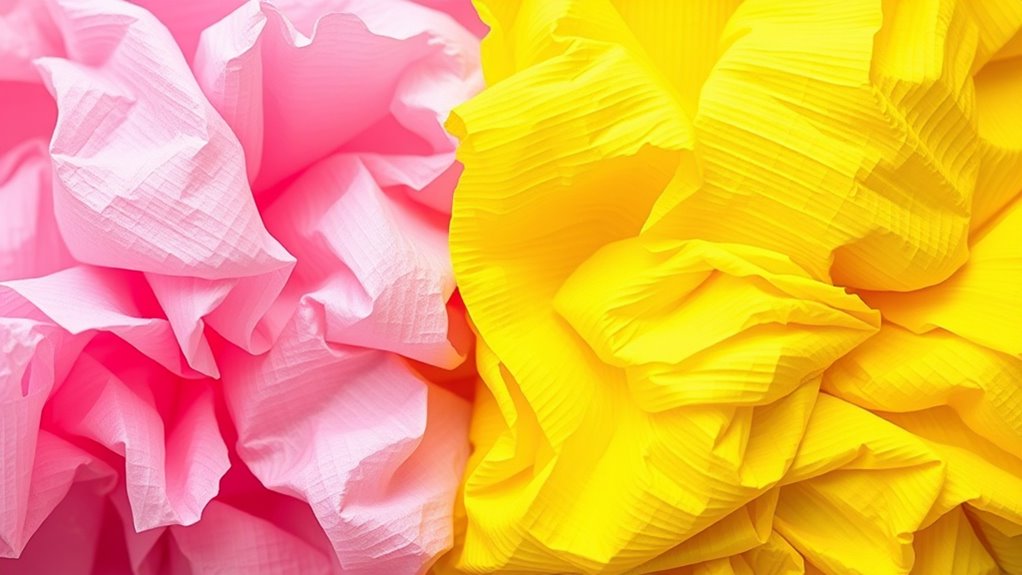
Tissue paper and crepe paper each serve a variety of common uses and applications that highlight their unique properties. You’ll often see tissue paper used for delicate gift wrapping or adding a soft touch to floral arrangements. Crepe paper, on the other hand, is popular for creating vibrant, textured decorations.
You might brighten up holiday celebrations with tissue paper snowflakes or use crepe paper for colorful banners and streamers. Both materials are essential in crafting and decorating, making your events more lively and personalized.
Some common uses include:
- Holiday decorations like wreaths and garlands
- Gift wrapping for presents of all sizes
- Craft projects and DIY art
- Party decorations and backdrops
- Floral arrangements and gift bags
Manufacturing Processes and Cost Factors

Manufacturing tissue paper and crepe paper involves distinct processes that influence their production costs. Tissue paper is produced through a straightforward process that emphasizes high-speed, large-scale pulping, and pressing, which promotes cost efficiency. Crepe paper, on the other hand, requires additional steps like creping or stretching the paper during production, adding to manufacturing complexity. This extra processing increases labor and equipment costs, making crepe paper generally more expensive to produce. The differences in manufacturing processes directly impact the overall cost factors, with tissue paper benefiting from economies of scale due to its simpler production. Conversely, crepe paper’s complexity limits economies of scale, raising its production costs. Understanding these factors helps explain why tissue paper tends to be more affordable than crepe paper.
Environmental Impact and Recycling

The production processes of tissue and crepe paper considerably influence their environmental footprints. You should know that recycling challenges often arise because these papers are coated or dyed, making them harder to process. Their environmental footprint is also affected by the resources used, like water and energy, during manufacturing. Imagine:
- Forests being cut down to supply raw materials
- Water streams contaminated by chemical treatments
- Waste piling up in landfills
- Energy consumption emitting greenhouse gases
- Difficulties in separating recyclable components
These factors highlight how tissue and crepe paper impact the environment differently. While both can be recycled, crepe paper’s unique texture and chemical treatments make recycling more complex. Your choices influence waste management and the overall environmental footprint of these materials.
Tips for Working With Tissue and Crepe Paper

Working with tissue and crepe paper requires a few key tips to achieve the best results. For decorative techniques, handle the paper gently to prevent tearing, especially when shaping or curling. Use sharp scissors for clean cuts, and consider layering for added texture. To keep your projects tidy, store your tissue and crepe paper properly; fold them flat or roll them to avoid creases and damage. Keep unopened packs in a cool, dry place, and reseal opened sheets using clips or rubber bands to maintain flexibility. When working with crepe paper, stretch it slightly to enhance its natural elasticity, making it easier to create ruffles or flowers. Following these tips will help you craft beautiful decorations with ease and longevity.
Choosing the Right Paper for Your Projects
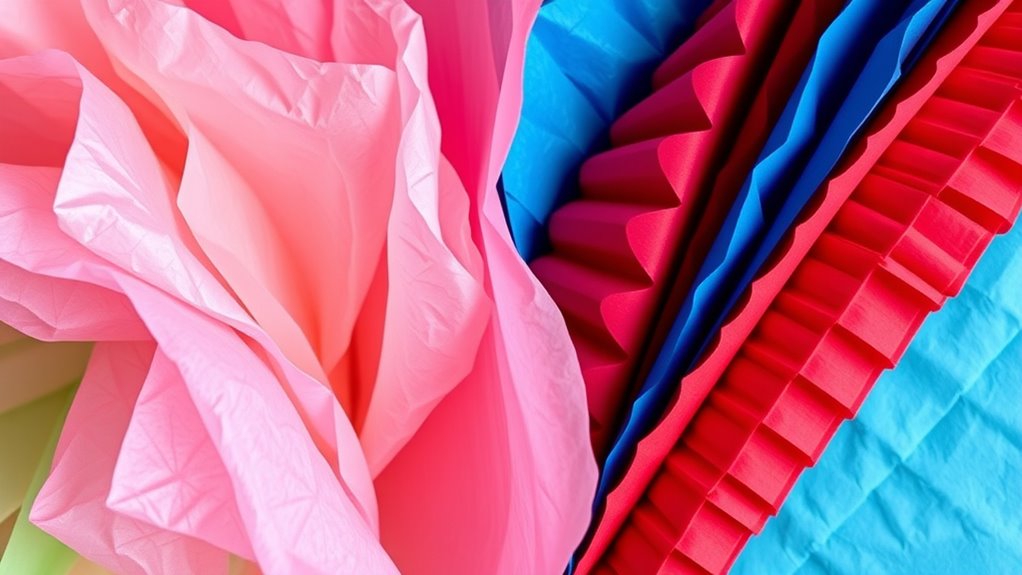
Choosing the right paper for your projects depends on understanding the unique qualities of tissue and crepe paper. Tissue paper offers a delicate, smooth texture perfect for elegant packaging options and lightweight crafts. Crepe paper provides a stretchy, textured surface, making it ideal for bold, dynamic decorations and intricate designs. Consider your project’s needs: do you want crisp, clean wrapping or flexible, textured shapes? Think about artistic versatility—tissue paper lends itself to soft, layered effects, while crepe paper excels in creating volume and movement. Visualize wrapping a gift in shimmering tissue or crafting vibrant floral arrangements with crepe paper. Both types bring different strengths, so choose based on the look, feel, and durability your project demands.
Frequently Asked Questions
Which Paper Is More Suitable for Delicate Gift Wrapping?
For delicate gift wrapping, tissue paper is your best choice. It offers wrapping elegance, making your gift look refined and sophisticated. Tissue paper’s soft, lightweight nature guarantees smooth, neat folds that enhance gift presentation. Crepe paper, being more textured and elastic, isn’t ideal for delicate wrapping. Instead, opt for tissue paper to achieve a polished, elegant look that highlights the care you put into your gift.
How Do Tissue and Crepe Paper Compare in Durability?
Think of tissue and crepe paper as delicate dancers on a stage. When it comes to durability, tissue paper isn’t as tough, with low tear resistance and high moisture sensitivity, making it prone to tearing easily. Crepe paper, however, offers better flexibility and strength, resisting tears better but still sensitive to moisture. So, if you need something more durable, crepe paper’s your best bet.
Can Both Papers Be Used for Outdoor Decorations?
You can use both tissue and crepe paper for outdoor decorations, but keep in mind their weather resistance and UV stability. Tissue paper isn’t very durable outdoors; it easily tears and fades when exposed to moisture and sunlight. Crepe paper fares slightly better due to its elasticity, but it still isn’t highly weather-resistant. To guarantee your decorations last, consider applying protective coatings or choosing more durable materials designed for outdoor use.
Are There Health Considerations When Handling These Papers?
Think of handling tissue and crepe paper like walking through a garden; you might encounter subtle allergies. You should be aware that some papers contain chemical contents that could trigger allergic reactions, especially if you have sensitive skin or allergies. It’s wise to wash your hands after handling or wear gloves. Staying cautious guarantees your creative process remains safe and enjoyable, without unexpected reactions ruining your decor experience.
How Do Their Drying Times Differ in Craft Projects?
When comparing drying times, you’ll notice tissue paper dries faster due to its higher absorption rate, quickly soaking up moisture during the drying process. Crepe paper, with its textured surface and lower absorption rate, takes longer to dry. If you’re working on a craft project, plan accordingly: tissue paper’s quick drying helps speed things up, while crepe paper’s slower process might require more patience to avoid smudging or tearing.
Conclusion
Choosing between tissue and crepe paper is like selecting the perfect brush for your canvas—each brings its own unique flair to your project. Tissue paper offers delicate, airy elegance, while crepe paper adds texture and stretch. By understanding their differences and uses, you can craft masterpieces that truly shine. So, pick your paper wisely, and let your creativity blossom like a vibrant garden, bringing your ideas to life with color and texture.






